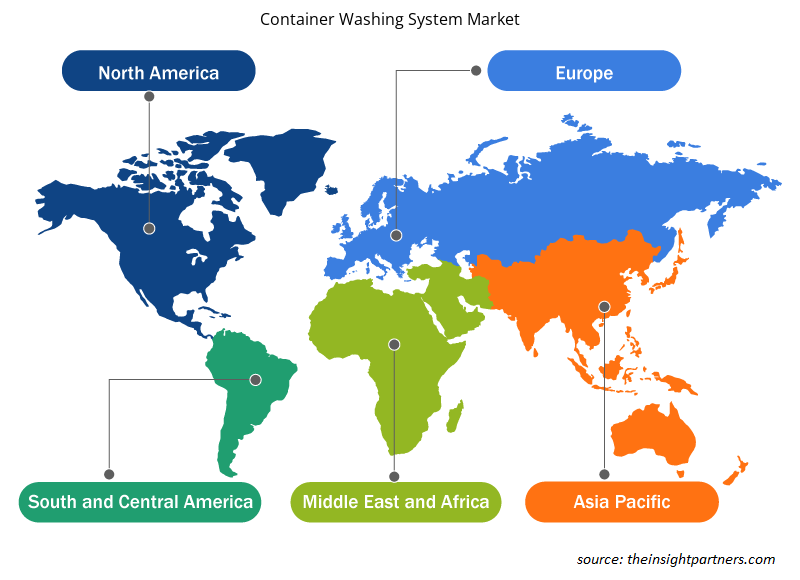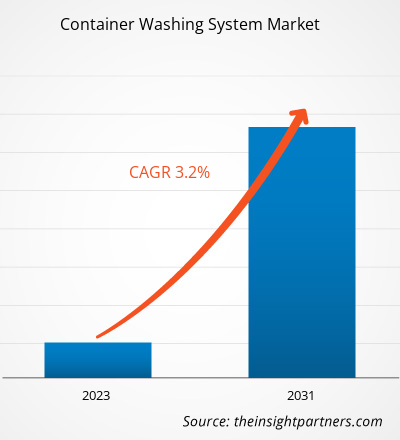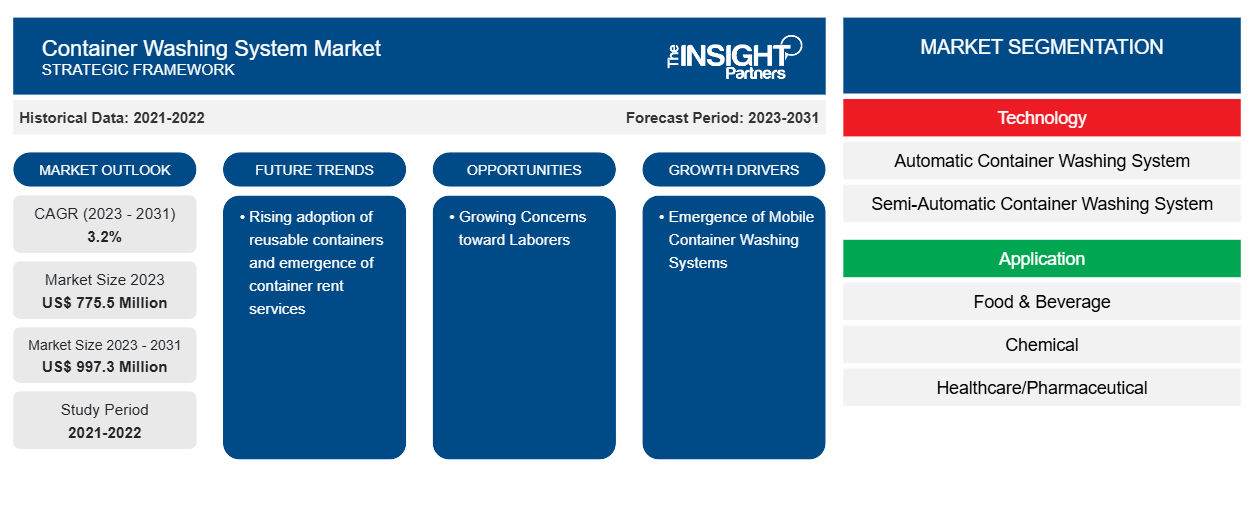La taille du marché des systèmes de lavage de conteneurs devrait atteindre 997,3 millions USD d’ici 2031, contre 775,5 millions USD en 2023. Le marché devrait enregistrer un TCAC de 3,2 % en 2023-2031. L’adoption croissante de conteneurs réutilisables et l’émergence de services de location de conteneurs sont parmi les principaux facteurs qui stimulent le marché des systèmes de lavage de conteneurs.
Analyse du marché des systèmes de lavage de conteneurs
Le marché mondial du lavage de conteneurs gagne du terrain en raison de l'adoption croissante de conteneurs réutilisables dans la chaîne d'approvisionnement pour le stockage et le transport et de l'émergence de conteneurs de location en raison de la dynamique très volatile des activités d'aujourd'hui. En outre, la tendance croissante à l'automatisation de diverses opérations dans les installations afin d'accroître l'efficacité globale fait partie des autres facteurs qui stimulent la croissance des systèmes de lavage de conteneurs. Cependant, le coût élevé des systèmes de lavage de conteneurs freine la croissance du marché des systèmes de lavage de conteneurs. Dans le même temps, la tendance croissante à la sécurité sur le lieu de travail devrait créer de nombreuses opportunités pour les acteurs du marché des systèmes de lavage de conteneurs.
Aperçu du marché des systèmes de lavage de conteneurs
L'industrie agroalimentaire mondiale utilise des caisses de différentes formes et tailles pour toutes sortes d'usages. Le nettoyage de ces caisses est l'un des processus importants de l'industrie avant le transport des produits alimentaires pour réduire la contamination. La population américaine est de plus en plus soucieuse de sa santé et se concentre sur la consommation de différents types et sources d' aliments transformés . Ainsi, la transformation globale de ces produits alimentaires nécessite une sécurité adéquate en nettoyant les conteneurs. De même, le secteur de la santé dans la région est en plein essor. Les dispositifs médicaux sont stockés dans des conteneurs pour éviter toute contamination, et ces conteneurs doivent être nettoyés périodiquement.
De même, l'industrie de fabrication de médicaments prend les précautions appropriées lors du mélange de la composition de différents produits chimiques dans un récipient lors de la fabrication de médicaments ; le nettoyage des récipients est donc une étape cruciale. Par conséquent, l'installation de systèmes de lavage de conteneurs se développe dans les secteurs de l'alimentation et des boissons et de la santé. Plusieurs fabricants de systèmes de lavage de conteneurs se concentrent sur le développement et l'expansion de leurs activités à travers le monde.
Personnalisez ce rapport en fonction de vos besoins
Vous bénéficierez d'une personnalisation gratuite de n'importe quel rapport, y compris de certaines parties de ce rapport, d'une analyse au niveau des pays, d'un pack de données Excel, ainsi que d'offres et de remises exceptionnelles pour les start-ups et les universités.
- Obtenez les principales tendances clés du marché de ce rapport.Cet échantillon GRATUIT comprendra une analyse de données, allant des tendances du marché aux estimations et prévisions.
Moteurs et opportunités du marché des systèmes de lavage de conteneurs
Apparition des systèmes de lavage de conteneurs mobiles
La plupart des systèmes de lavage de conteneurs développés sont stationnaires. En raison de la dynamique changeante des activités commerciales et pour surmonter l'obstacle du transport des conteneurs jusqu'au lieu de lavage, Villiger Entsorgungssysteme AG propose des systèmes de lavage de conteneurs mobiles. Le système de lavage de conteneurs est monté à l'arrière du camion et fonctionne au diesel. Le système de lavage de conteneurs est équipé d'une buse haute pression et de brosses pour le nettoyage des conteneurs semi-enterrés, hors sol et enterrés. Le système est également fixé aux bacs collecteurs et aux réservoirs pour les eaux usées et l'eau douce. Le système de lavage de conteneurs mobile élimine la nécessité d'une installation du système à un endroit spécifique, ce qui permet une flexibilité et réduit les coûts de transport d'un grand nombre de conteneurs d'un endroit à un autre pour les opérations de nettoyage.
Inquiétudes croissantes concernant l'hygiène et la sécurité des travailleurs
La sécurité sur le lieu de travail est l'un des paramètres cruciaux pour les organisations. Les organisations sont tenues de fournir l'infrastructure nécessaire en matière de santé et de sécurité des employés. Les ouvriers travaillant dans des installations qui traitent des substances dangereuses, telles que des produits chimiques toxiques, doivent être équipés du matériel et des équipements de sécurité nécessaires pour effectuer diverses opérations. Les normes réglementaires en matière d'hygiène et d'assainissement dans les secteurs de l'alimentation et des boissons et de la santé sont de plus en plus strictes. Ainsi, le besoin croissant de sécurité sur le lieu de travail, soutenu par des normes d'hygiène et d'assainissement de plus en plus strictes, devrait créer de nombreuses opportunités pour les acteurs opérant sur le marché des systèmes de lavage de conteneurs.
Analyse de segmentation du rapport sur le marché des systèmes de lavage de conteneurs
Les segments clés qui ont contribué à l’élaboration de l’analyse du marché des systèmes de lavage de conteneurs sont la technologie et l’application.
- Sur la base de la technologie, le marché des systèmes de lavage de conteneurs a été divisé en systèmes de lavage de conteneurs automatiques et systèmes de lavage de conteneurs semi-automatiques. Le segment des systèmes de lavage de conteneurs automatiques détenait une part de marché plus importante en 2023.
- En fonction de l'application, le marché des systèmes de lavage de conteneurs a été divisé en aliments et boissons, produits chimiques, soins de santé/pharmaceutiques, pétrole et gaz, etc. Le segment des aliments et des boissons détenait une part de marché plus importante en 2023.
Analyse des parts de marché des systèmes de lavage de conteneurs par zone géographique
La portée géographique du rapport sur le marché des systèmes de lavage de conteneurs est principalement divisée en cinq régions : Amérique du Nord, Europe, Asie-Pacifique, Moyen-Orient et Afrique et Amérique du Sud.
L'Asie-Pacifique a enregistré le taux de croissance le plus élevé sur le marché des systèmes de lavage de conteneurs au cours de la période de prévision. La région Asie comprend l'Australie, la Chine, l'Inde, le Japon, la Corée du Sud et le reste de l'Asie-Pacifique. L'Asie-Pacifique se caractérise par une industrialisation rapide, des revenus disponibles en hausse et une importante population jeune. L'Asie-Pacifique devrait créer les plus grandes opportunités de croissance en raison de l'adoption croissante des aliments emballés dans la région. En outre, le taux de croissance élevé du secteur pharmaceutique et de la santé, associé à la consommation croissante de combustibles fossiles dans la région APAC, propulse par la suite la croissance du marché. L'industrie pétrolière et gazière de la région devrait connaître une augmentation des fusions et acquisitions et des décisions finales d'investissement (FID). La croissance du secteur pétrolier et gazier alimentera les activités en amont et en aval, c'est-à-dire la demande croissante de l'industrie pétrolière et gazière en systèmes de lavage de conteneurs utilisés pour le stockage et le transport du pétrole. Ainsi, l'augmentation des investissements dans l'ensemble de l'industrie pétrolière et gazière accélérerait l'adoption de systèmes de lavage de conteneurs.
Aperçu régional du marché des systèmes de lavage de conteneurs
Les tendances et facteurs régionaux influençant le marché des systèmes de lavage de conteneurs tout au long de la période de prévision ont été expliqués en détail par les analystes d’Insight Partners. Cette section traite également des segments et de la géographie du marché des systèmes de lavage de conteneurs en Amérique du Nord, en Europe, en Asie-Pacifique, au Moyen-Orient et en Afrique, ainsi qu’en Amérique du Sud et en Amérique centrale.

- Obtenez les données régionales spécifiques au marché des systèmes de lavage de conteneurs
Portée du rapport sur le marché des systèmes de lavage de conteneurs
| Attribut de rapport | Détails |
|---|---|
| Taille du marché en 2023 | 775,5 millions de dollars américains |
| Taille du marché d'ici 2031 | 997,3 millions de dollars américains |
| Taux de croissance annuel composé mondial (2023-2031) | 3,2% |
| Données historiques | 2021-2022 |
| Période de prévision | 2023-2031 |
| Segments couverts | Par technologie
|
| Régions et pays couverts | Amérique du Nord
|
| Leaders du marché et profils d'entreprises clés |
|
Densité des acteurs du marché : comprendre son impact sur la dynamique des entreprises
Le marché des systèmes de lavage de conteneurs connaît une croissance rapide, tirée par la demande croissante des utilisateurs finaux en raison de facteurs tels que l'évolution des préférences des consommateurs, les avancées technologiques et une plus grande sensibilisation aux avantages du produit. À mesure que la demande augmente, les entreprises élargissent leurs offres, innovent pour répondre aux besoins des consommateurs et capitalisent sur les tendances émergentes, ce qui alimente davantage la croissance du marché.
La densité des acteurs du marché fait référence à la répartition des entreprises ou des sociétés opérant sur un marché ou un secteur particulier. Elle indique le nombre de concurrents (acteurs du marché) présents sur un marché donné par rapport à sa taille ou à sa valeur marchande totale.
Les principales entreprises opérant sur le marché des systèmes de lavage de conteneurs sont :
- Groupe d'équipement Dyetech, Inc.
- Systèmes de nettoyage Feistmantl GmbH
- Glatt GmbH
- HOBART GmbH
- Système de nettoyage Kärcher Pvt. Ltd.
- Numafa Nettoyage & Automatisation BV
Avis de non-responsabilité : les sociétés répertoriées ci-dessus ne sont pas classées dans un ordre particulier.

- Obtenez un aperçu des principaux acteurs du marché des systèmes de lavage de conteneurs
Actualités et développements récents du marché des systèmes de lavage de conteneurs
Le marché des systèmes de lavage de conteneurs est évalué en collectant des données qualitatives et quantitatives après des recherches primaires et secondaires, qui comprennent d'importantes publications d'entreprise, des données d'association et des bases de données. Voici une liste des développements sur le marché des systèmes de lavage de conteneurs et des stratégies :
- En octobre 2023, Newman a dévoilé de nouveaux avantages avec Archview Tank Wash. Cela a renforcé la présence et l'offre de produits de l'entreprise sur ce marché.
- En novembre 2020, les partenaires de SF Engineering chez UNIKON ont apporté plusieurs améliorations techniques à la série de laveuses industrielles UN pour rendre les machines encore plus hygiéniques. Parmi les améliorations apportées figurent le chanfrein pour l'évacuation de l'eau, l'extension du réservoir, les vis au lieu de la soudure, la modernisation du filtre rotatif, l'armoire de commande, les zones séparées, le raccordement du ventilateur et des lames d'air et l'évacuation de l'eau de condensation.
Rapport sur le marché des systèmes de lavage de conteneurs et livrables
Le rapport « Taille et prévisions du marché des systèmes de lavage de conteneurs (2021-2031) » fournit une analyse détaillée du marché couvrant les domaines ci-dessous :
- Taille du marché et prévisions aux niveaux mondial, régional et national pour tous les segments de marché clés couverts par le périmètre
- Dynamique du marché, comme les facteurs moteurs, les contraintes et les opportunités clés
- Principales tendances futures
- Analyse détaillée des cinq forces de Porter
- Analyse du marché mondial et régional couvrant les principales tendances du marché, les principaux acteurs, les réglementations et les développements récents du marché
- Analyse du paysage industriel et de la concurrence couvrant la concentration du marché, l'analyse de la carte thermique, les principaux acteurs et les développements récents
- Profils d'entreprise détaillés avec analyse SWOT
- Analyse historique (2 ans), année de base, prévision (7 ans) avec TCAC
- Analyse PEST et SWOT
- Taille du marché Valeur / Volume - Mondial, Régional, Pays
- Industrie et paysage concurrentiel
- Ensemble de données Excel
Rapports récents
Témoignages
Raison d'acheter
- Prise de décision éclairée
- Compréhension de la dynamique du marché
- Analyse concurrentielle
- Connaissances clients
- Prévisions de marché
- Atténuation des risques
- Planification stratégique
- Justification des investissements
- Identification des marchés émergents
- Amélioration des stratégies marketing
- Amélioration de l'efficacité opérationnelle
- Alignement sur les tendances réglementaires





















 Obtenez un échantillon gratuit pour - Marché des systèmes de lavage de conteneurs
Obtenez un échantillon gratuit pour - Marché des systèmes de lavage de conteneurs